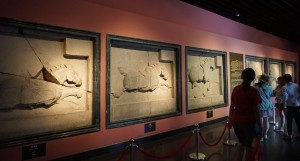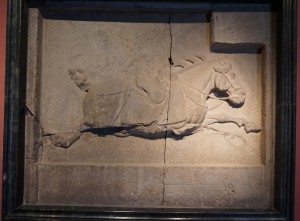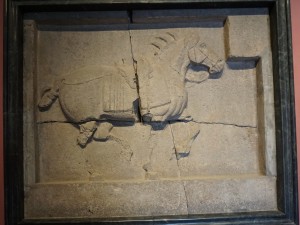The Six Steeds of Zhao Mausoleum are six 7th century Chinese stone reliefs of Emperor Taizong of Tang's (r. 626-649) horses.

Two of them, the bottom left one (6-4) and the bottom middle one (6-5) in the above stamps, were smuggled to the U.S. in 1916 and currently are in the museum at the University of Pennsylvania.
The other four are in the Forest of Stelae museum in Xi'an, China, and we viewed the originals:

However, these precious art pieces were already cut into pieces in 1910s by the smugglers. Who said ancient masterpieces of art had been shipped to the US or European countries in order to get better preserved?


When I visited the Beilin Museum, I was saddened to see a polite inference that the Steeds of Zhou in Philadelphia had been looted. I remembered them there from my visits as a boy to the University of Pennsylvania Museum.
During the period we lived in China, I met friends who are interested in having the two steeds that are in Philly returned to Xi'An. A few years ago, after some preliminary work, it seemed apparent that while the steeds were looted, and then sold to the UofP, that the timing for their return was not right.
I do not mean to demean the University on this topic. The purchase of the steeds from CT Loo was financed by Edridge Johnson, inventor of the Victor Talking Machine (his son was a friend of my 93 year old father, and my Dad has at least second hand knowledge of his good character). That said, no one would have the right to alienate these cultural treasures from China - not Pu Yi himself.
Those interested in working on the return of the steeds to China should feel free to contact me. Find me on linked in easily.
William M. Scott IV
I have been researching these horses for some time now. My grandparents were married in China in 1914, my grandfather went out to China from England in 1902 to work for the Chinese Postal Service and my grandmother was born in Foochow in 1893. My grandfather was moved to various cities over the 28 years he spent there and as he moved in his position met and worked with many important Chinese, some of whom in the early years were Mandarins and other government officials. As a result the brought back to England and eventually to America many wonderful Chinese treasures which after they and my parents passed on were given to me and my 3 siblings. Anyway, I have 2 of the rubbings, one is Quingzjui who is galloping towards the right. He has 4 arrows in his rump. The other I am not sure of as it is not one of the 6 that are usually shown and described at online websites. But I believe it is also from this period. It has a rider on horseback with a long spear and some Chinese script on the top and left edge. I recently asked the Penn Museum's Asian department if they could identify it but have not heard back. Let me know if you would like to see a copy of it. Perhaps you can identify it.
As to the return of the ones at the Penn Museum, I doubt it will happen anytime soon. Some museums are making amends such as in the case of art that was looted by the Nazis but the Elgin Marbles are an example of the reluctance of Western museums to return things to their original homes. I believe I read that the Penn Museum bought the stones in good faith that they were being legitimately sold by a reputable seller. I think that's a stretch. They probably knew they were removed without permission but at that time there was so much turmoil in China that it didn't seem to matter.
Have a nice day. Let me know if you want to see that print I mentioned.